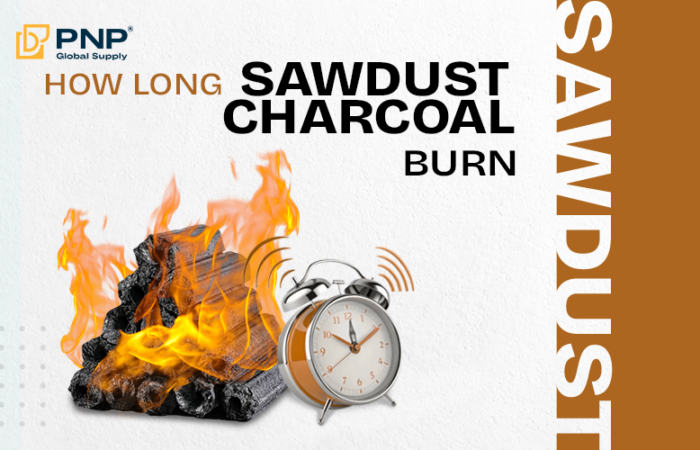Coconut briquette charcoal is becoming an increasingly popular choice in the renewable energy industry, not only thanks to its efficient combustion properties but also the environmental benefits it brings. As more and more people look for green solutions to their energy consumption needs, producing charcoal from coconut shells not only helps reduce waste but also provides a sustainable and safe source of energy. In this article, we will explore the step-by-step process to make briquette charcoal from coconut!
What is coconut briquette charcoal?
Coconut briquette charcoal is charcoal produced from coconut shells or leftover parts of coconut trees, through compression and heating without oxygen. This product has a tablet shape, making it easy to transport and use.

Structure and properties of coconut briquette charcoal?
Coconut briquette charcoal has a porous structure, with many small holes that help increase heat retention and reduce smoke when burning. Outstanding features of coconut briquette charcoal include:
- High heat: Coconut briquette charcoal has the ability to generate good heat, usually higher than regular charcoal.
- Long burning time: Thanks to its compact structure, coconut briquette charcoal can burn longer, saving time and fuel.
- Less smoke and odor: When burned, coconut briquette charcoal produces less smoke and odor, making it an ideal choice for indoor or outdoor activities.

Compare with other types of charcoal
When compared to charcoal and wood charcoal, there are some distinct differences:
- Heat: Coconut briquette charcoal usually has a higher heat than charcoal, helping to save cooking time.
- Burning time: coconut briquette charcoal burns longer than charcoal, while wood charcoal can burn faster but does not retain heat for long.
- Smoke and Odor: Coconut briquette charcoal produces less smoke and odor than charcoal, making it friendlier to the environment and human health.
Why should you use coconut briquette charcoal?
Coconut briquette charcoal has many outstanding advantages compared to other types of charcoal, such as:
- Easy to find and reasonable price: Coconut is a popular tree in many regions, so the raw materials to produce briquette charcoal from coconut are very easy to find. Furthermore, production costs are often lower than other types of plants, helping consumers save costs.
- High quality: Coconut briquette charcoal has high hardness, making it not easy to break during transportation and use. The burning time of coconut charcoal is also very long, bringing high efficiency to consumers. This makes coconut charcoal an ideal choice for cooking and heating activities.
Process of making coconut briquette charcoal
1. Ingredients Preparation
First, you need to collect a large amount of coconut shells from sources such as coconut processing factories or coconut production areas. After collection, it is necessary to dry it well in the sun or in a ventilated environment to remove moisture, ensuring that the coconut shells used in the charcoal production process will be moisture-free, helping to The carbonization process is more efficient. This preparation is very important, because if the coconut shell is too wet, it will reduce the quality of the final product.

2. Carbonization
Next, you need to build a closed furnace with the necessary characteristics to carry out the carbonization process. Put the prepared coconut shell into the oven, then light a fire inside the oven.
During this process, care should be taken to adjust the amount of oxygen supplied. Due to too much oxygen can lead to complete combustion instead of carbonization, losing the quality of the charcoal. This carbonization process usually lasts from a few hours to a day depending on the type of furnace and temperature used, and needs to be constantly monitored to ensure that it occurs evenly.

3. Mill
After completing the carbonization process, the charcoal will be cooled. When the charcoal has cooled enough, grind the charcoal into small pieces using a specialized crusher.
This grinding is important because it will affect the quality and consistency of the final briquette charcoal product. The charcoal pieces need to be uniform in size for ease of mixing and pressing later.

4. Mix
After grinding, you will combine the charcoal with a natural binder, like tapioca starch or corn starch, along with a certain amount of water. This mixing process helps the ingredients bond tightly together, creating durability for the charcoal briquette. Keeping the ratio between charcoal, binder and water reasonable is very important, because if there is little water, the charcoal pellets will not have enough moisture to bond, and if there is too much, the charcoal pellets will be mushy and easily break.
5. Casting
After mixing well, the mixture will be put into the mold to shape. The molds will help the charcoal have a uniform shape and make it easier to preserve and use later.
Many different molds can be used to create different shapes of charcoal pellets, such as round, rectangular or hexagonal pellets. After the mold has been cast, it is necessary to dry it so that the charcoal pellets are completely dry and firm, this also contributes to improving the quality of the final product.

6. Preservation
Finally, after the briquettes have dried, you need to store them in a cool, dry place. Proper storage is important to ensure the quality of charcoal is not affected by humidity or other external factors such as strong sunlight, or high temperatures. An ideal storage should have low humidity, good ventilation and avoid direct light to help the charcoal maintain its properties over a long period of time.
This process not only helps recycle coconut shells effectively but also creates environmentally friendly fuel. By reducing the amount of waste from coconut shells, we are contributing to protecting the environment, while providing a sustainable and safe source of energy for users, supporting living and production activities. without harming the surrounding environment.
Tips and notes when making coconut briquette charcoal
To create quality and effective batches of coconut briquette charcoal, the first thing you need to pay attention to is the choice of ingredients.
- Use old coconuts, as they will provide more fiber and provide better quality charcoal. Thick and dark brown coconut shells often contain more organic matter, helping the charcoal after processing to have high durability and heat capacity.
- Consider the ratio of ingredients needed, this may vary depending on the type of adhesive you use as well as the moisture content of the ingredients.
- Attention should be paid to the temperature and heating time during the charcoal making process. Temperatures that are too high or too low can affect the quality and durability of the final char.
- Firing time also needs to be strictly controlled, because if not heated for enough time, the charcoal will not be completely dry and an unpleasant odor may arise when used. On the contrary, if heated for too long, the charcoal may burn and lose many nutrients.
- Make sure the workspace well ventilated. Carrying out the processing process in an unventilated environment is dangerous, not only for the health of the person performing it but also reduces product quality.
- Take safety measures when working with fire and high temperatures. Wear labor protection and prepare firefighting equipment when necessary to ensure the coconut briquette charcoal making process is safe and effective.
Benefits of producing and using coconut briquette charcoal
The production and use of coconut briquette charcoal brings many significant benefits to the environment and human health, including:
- High absorption capacity: With good absorption capacity, helping to remove toxic substances in air and water. This makes it an ideal choice for water filtration and exhaust gas treatment. It helps contribute to improving the quality of the living environment.
- Diverse applications: not only used in industrial fields but also has applications in beauty and health. For example, it can be used in skin care products thanks to its ability to absorb and purify, helping the skin become healthier.
- Environmental protection: Using coconut briquette charcoal also helps reduce the amount of waste from coconuts. Also minimizing the exploitation of natural wood, thereby protecting forests and ecosystems.
Conclusion
Coconut briquette charcoal is not only environmentally friendly but is also used in water filtration, improving quality of life and in agriculture to enhance plant health. We encourage you to share your experiences and use coconut briquette charcoal effectively, thereby raising awareness about sustainable products and environmental protection. Let’s develop green products together for a better future!
________________________________
Contact us for more information
Facebook: PNP Charcoal
Instagram: PNP Charcoal
Email: info@pnpglobalsupply.com




